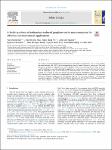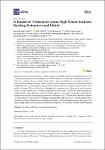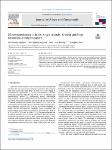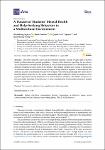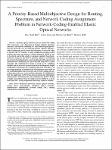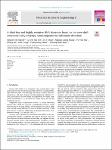Search
Author
- Nguyen Huu Tung (3)
- Dao Thanh Hai (2)
- Ho, Manh Tung (2)
- Tu Le Manh (2)
- next >
Subject
- Affective computing (2)
- Artificial Intelligence (2)
- Danshen (1)
- Lamiaceae (1)
- next >
Date issued
Has File(s)
- true (19)
Search Results
Network coding (NC) has been recently emerging as an excellent technique for leveraging network efciency. In optical networks, NC and protection appear to be a good match and indeed, NC could be efectively exploited for greater protection efciency thanks to the opportunity of combining signals rather than duplication in the traditional approach. Motivated by this observation, we investigate the application of a simple and practical NC technique based on XOR operation to improve the network throughput in survivable optical networks. To this end, we propose the NC-based protection whose speed recovery is on a par with the conventional 1 + 1 dedicated protection while the capacity usage could be more efcient, paving the way for improving throughput in constrained capacity conditions. A... |
In this study, we present a low-cost and simple method to treat spent lead–acid battery wastewater using quicklime and slaked lime. The sulfate and lead were successfully removed using the precipitation method. The structure of quicklime, slaked lime, and resultant residues were measured by X-ray diffraction. The obtained results show that the sulfate removal efficiencies were more than 97% for both quicklime and slaked lime and the lead removal efficiencies were 49% for quicklime and 53% for slaked lime in a non-carbonation process. After the carbonation step, the sulfate removal efficiencies were slightly decreased but the lead removal efficiencies were 68.4% for quicklime and 69.3% for slaked lime which were significantly increased compared with the non-carbonation process. This ... |
This review article summarizes the recent development of flexible piezoelectric nanogenerators based on organic-inorganic metal halide perovskite (OMHP) materials and their polymer composites. Dielectric, ferroelectric and piezoelectric properties of OMHPs are also discussed in detail. |
The synthesis of advanced functional nanomaterials for electrochemical applications, such as water splitting, dye-sensitized solar cells (DSCs), and supercapacitor has been the topic of interest in recent years. This work presents the synthesis of ruthenium (Ru)/reduced graphene oxide (RGO) nanocomposite by using a facile and scalable liquid plasma-assisted method and its application as an electrode material in electrochemical applications for supercapacitor and triiodide reduction at counter electrodes (CEs) of DSCs. As the results, Ru nanoparticles have a size in the range of 4–10 nm that were homogenously distributed on the surface of the RGO layer. Electrochemical measurements demonstrated that the synthesized material is suitable for supercapacitor applications, whereas the cap... |
Books are the invaluable, colossal storage of mankind’s immense scholarship and are still commonly perceived as a more reliable source of knowledge even in this age of digitized information. Extensive reading is often promoted as being vital to cognitive development, especially for students in primary and secondary education. While it could now be considered common knowledge that reading is highly beneficial, reading habits vary among individuals in the same culture and receiving the same public education. This could be due to demographic variations and differences in socioeconomic status, or other factors such as family background and education. Despite the ample literature on reading habits, there still exists a lack of holistic approach with empirical results concerning the recip... |
University students, especially international students, possess a higher risk of mental health problems than the general population. However, the literature regarding the prevalence and determinants of mental health problems as well as help-seeking behaviors of international and domestic students in Japan seems to be limited. This dataset contains 268 records of depression, acculturative stress, social connectedness, and help-seeking behaviors reported by international and domestic students at an international university in Japan. One of the main findings that can be drawn from this dataset is how the level of social connectedness and acculturative stress are predictive of the reported depression among international as well as domestic students. The dataset is expected to provide re... |
In this study, we present a low-cost and simple method to treat spent lead–acid battery wastewater using quicklime and slaked lime. The sulfate and lead were successfully removed using the precipitation method. The structure of quicklime, slaked lime, and resultant residues were measured by X-ray diffraction. The obtained results show that the sulfate removal efficiencies were more than 97% for both quicklime and slaked lime and the lead removal efficiencies were 49% for quicklime and 53% for slaked lime in a non-carbonation process. After the carbonation step, the sulfate removal efficiencies were slightly decreased but the lead removal efficiencies were 68.4% for quicklime and 69.3% for slaked lime which were significantly increased compared with the non-carbonation process. This ... |
A core-shell cerium oxide nanorod@polypyrrole (CeO2-NR@Ppy) nanocomposite-based electrochemical DNA biosensor was studied for Salmonella detection. The core-shell CeO2-NR@Ppy nanocomposite was prepared by in situ chemical oxidative polymerization of pyrrole monomer on CeO2-NRs, which provided a suitable platform for electrochemical DNA biosensor fabrication. The immobilization of ss-DNA sequences onto nanocompositecoated microelectrode was performed via covalent attachment method. DNA biosensor electrochemical responses were studied by cyclic voltammetry and electrochemical impedance spectroscopy with [Fe (CN)6] 3−/4− as redox probe. Under optimal conditions, DNA biosensor response showed good linearity in the range of 0.01–0.4 nM with sensitivity of 593.7 Ω·nM−1·cm−2. The low limit... |




